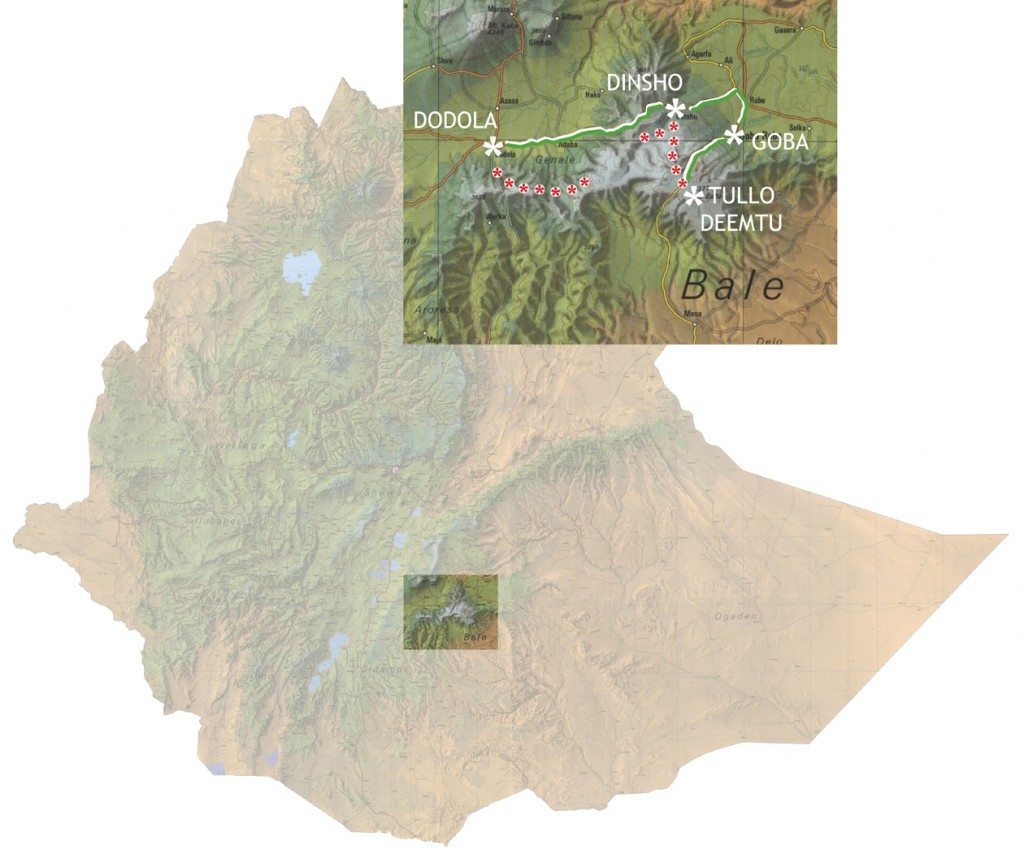The Bale Mountains National Park is home to Ethiopia’s second highest mountain range. The landscape is wild and rough, and the African mountain vegetation is magnificent. At an altitude of 4,000 metres the Sanetti Plateau stretches far and wide, with the second highest mountain in Ethiopia, the Tullo Deemtu (literally translated to ‘Red Mountain’ with an altitude of 4,377 metres) rising majestically above the plateau. This region is well worth the visit, particularly in the fall when the landscape is filled with the colours of the wild flowers. South of the Sanetti Plateau at a slightly lower altitude is the Harenna Forest, a large, densely filled woodland.
The Bale Mountains originated from volcanoes and are popular among birdwatchers for the dozens of endemic bird species which can be found here. Furthermore, the distribution radius of many of the species of birds is quite small, even within the Bale Mountains. But not only birdwatchers can enjoy this trip. The Bale Mountains are full of many different animal species, including endemic species such as the Ethiopian wolf, Menelik’s bushbuck or the rare mountain nyala with only 1,000 animals within the park. Even lions, leopards and African wild dogs can be found here, although these are rare and difficult to spot.
The Bale Mountains are, so far, rarely visited by tourists, and therefore they offer many possibilities to explore undisturbed landscapes and wildlife, whether on foot or horseback. The park headquarters is located in Dinsho, where single or multi-day trekking tours can be arranged. In addition, rides of various durations on horse or pony are also possible (even for several days length). A well-developed network of hiking trails, including overnight huts are also available in Dodola, just before the boundaries of the National Park (see below). Another attractions is Africa’s highest elevated all-weather road, which travels from Goba and over the Sanetti Plateau. Find possible tours in the Bale Mountains under: OUR TOURS, Nature Experience in Bale.
…
Nearby: Approximately 150 kilometres East of the National Park you’ll find the Sof Omar Caves, a place definitely worth a visit.
Meals and Accommodation: Near the parks headquarters in Dinsho is the Dinsho Lodge with the possibility to stay overnight in rooms of different sizes. The lodge is equipped with a communal kitchen and shared bathrooms and showers but restaurants are only located in the village itself. Designated camping grounds can also be found inside the park. Awura Tours will be happy to supply the camping and cooking equipment required. Since it is quite cool at night we recommend bringing a warm sleeping bag.
Guides and Pack Animals: Hiking tours are led by trained guides who are members of the Nyala Guides Association. Pack animals and mounts can also be arranged at the park headquarters.
Difficulty: Hiking in the Simien Mountains is possible with good health and an overall good physical fitness level and stamina. Some may experience difficulty due to the altitude, however these problems are usually minimal.
Wildlife: For ornithologists, the Bale Region is one of the most important areas in the country for bird watching. At least 16 endemic birds are found in the Bale National Park, and rare birds of prey circle over the Sanetti Plateau. There is also the chance to see other predators such as the Ethiopian wolf. Other endemics are mountain nyala, Menelik’s bushbuck and the localized bamboo-dwelling Bale monkey, also klipspringer and golden jackals are present. Commonly seen mammals of the woodlands include guereza monkey, vervet monkey, olive baboon, warthog, bohor reedbuck and bushpig. Even predators such as lion, leopard and African wild dog have been spotted in the Bale Mountains although they are very rarely seen.
.
.
Hiking at Dodola
South of Dodola offers some of the best-developed areas for hiking in Ethiopia. With foreign support, a network of trails has been constructed, as well as five mountain huts and a permanent tented camp offering affordable accommodation. The project focuses on ecotourism as a long-term means to preserve the habitat.
Walking tours depart from the project office in Dodola, where horses can be rented, whether for riding or for carrying equipment. Past Dodola, the trail leads through beautiful scenery and landscapes. African mountain forests with juniper bushes and hagenia (or African redwood) cover the hillsides. Ancient giant trees, some over 500 years old, line the route and mountain ranges fill the horizon. In terms of wildlife, the animals found here are similar to those found in the Bale Mountains, although mountain nyala, Menelik’s bushbucks and Ethiopian wolfs are less often seen here than in the park itself.
A full tour of the area requires six days. However, shorter walks are also possible, particularly because the first three lodges are quite centrally located. All hikes are guided.
Meals & Accommodation: Accommodation is available in five simple, but fully-equipped cabins as well as a permanent tented camp. All cabins have a kitchen and it is possible to bring and prepare your own food. Optionally, the warden of the camp also prepares simple meals.
.
.

